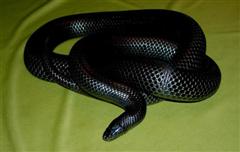Milksnake - Black
Black Milk Snake Scientific Name: Lampropeltis triangulum gaigeae
Thu, 17th April, 2025 - 8:20 am GMT
Sponsor Ads:

Alternative Name
Black Milk Snake Scientific Name: Lampropeltis triangulum gaigeaeBasic Info
Significantly larger than other milk snakes, an adult Black Milksnake is likely to reach around six feet in length. The largest known specimen, the male at the San Antonio Zoo, is recorded at seven feet, two inches. They are very heavy and dense. Mature adults are a solid, glossy black. In light, the light color between the scales can be seen. Hatchling Black Milksnakes are tri-colored with bright markings and black tipping on the scales. However, they quickly darken to jet-black. The white and yellow bands darken first, and then the red bands. Some of the pattern may still be seen on the belly. They darken more quickly in cooler temperatures.
Health
Black Milksnakes should always be kept at temperatures in the low to mid 70s. Higher temperatures, like those often kept in a snake room, can result in overeating, frequent shedding, and fertility problems. They should feel cool to the touch: if they feel warm or neutral, the temperature is probably too high. They should be provided with a shallow pool of water and plenty of hiding places. Breeding Black Milksnakes usually breed after hibernating - in April and May. Warm temperatures will significantly alter the breeding cycle. Warmer temperatures may result in the snakes not breeding at all, retaining eggs, or producing only male offspring. It has been reported that size, not age, is the most important factor when determining if a female is ready to lay eggs. You can breed a smaller snake, such as an 18" yearling, but she will usually become egg-bound. After breeding eggs should be incubated at 80 degrees Fahrenheit. After birth hatchlings should be kept between 76 and 82 degrees Fahrenheit. This is good for the first year or so. Obesity is usually not a problem for the first two years, and the animals are best brumated much like any other milk or king, once they reach at least 4 feet in length.Habitat
N/ABehavior
The Black Milksnake is a large milksnake native to the high mountains of Costa Rica. They have only recently become readily available to private owners. While easy to care for, the Black Milksnake has some specific care requirements, particularly temperature related. They should only be kept by those willing to make the necessary adjustments. The Black Milksnake, while native to tropical regions, is from high altitude areas that rarely exceed the mid 70s (Fahrenheit) in temperature. This is probably one reason for the black color as it helps the snake absorb heat while basking. If they are kept at temperatures warmer than this, they are prone to obesity and frequent shedding. They enjoy submerging themselves in water or damp moss to cool down. The Black Milk Snake spends much of its time in hiding. When hungry, they will emerge to hunt or, in captivity, wait for food. They generally feed on small vertebrates such as mice. They hibernate, usually in February and March, and breed in April and May.Origin
Costa RicaHistory
The Black Milksnake is native to Costa Rica. They are still rare in private collections because only recently have the specific care requirements become known.Common Foods
They are valued as wild animals on the farm and in urban areas as they eat mice and other rodents.Sponsor Ads:
All my life, I have done what was expected of me. It never occurred to me to do otherwise. Now, I wonder what might have been. The future frightens us, the past tempts us, and our lives slip away, lost in the terrible moment in between. -- Londo, Babylon 5
Milksnake - Black
Coded by: BGID® | ALL RIGHTS RESERVED Copyright © 2000-2025
Disclaimer | Privacy | Report Errors / Contact | Credits








 Why haven't we as a collective earth met with aliens yet?
Why haven't we as a collective earth met with aliens yet?  The Best Text Adventure You Will Ever Play! The official site:
The Best Text Adventure You Will Ever Play! The official site:  Homosexual behavior stems from the mind or genetics?
Homosexual behavior stems from the mind or genetics?  World EcoSystem - Biodiversity Changes - Who is on board and who isn
World EcoSystem - Biodiversity Changes - Who is on board and who isn  Mouthwash - Mouthrinse - Mouth Sores - Healing Infections - Gingivitis
Mouthwash - Mouthrinse - Mouth Sores - Healing Infections - Gingivitis  Treatment for Depression
Treatment for Depression  Ultra radical and violent Islamist group that even rivals Al Qaeda
Ultra radical and violent Islamist group that even rivals Al Qaeda  An idea to have teachers who want to carry guns to school undergo some level of police training will be left up to local school districts and police departments.
An idea to have teachers who want to carry guns to school undergo some level of police training will be left up to local school districts and police departments.